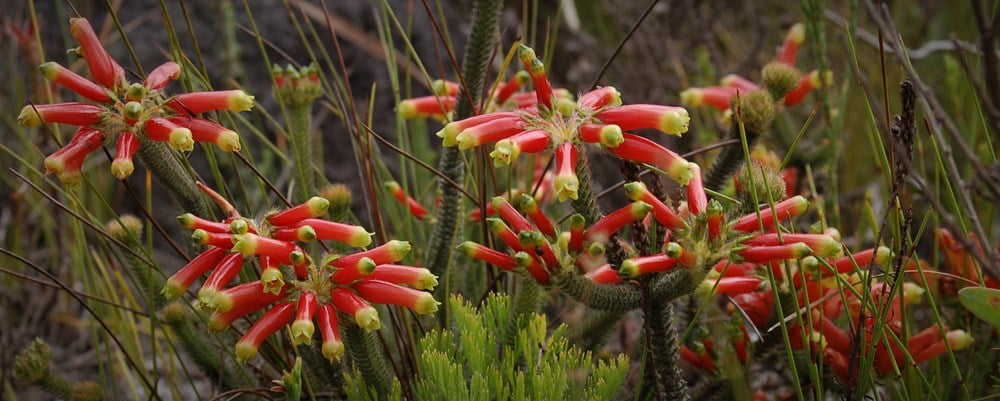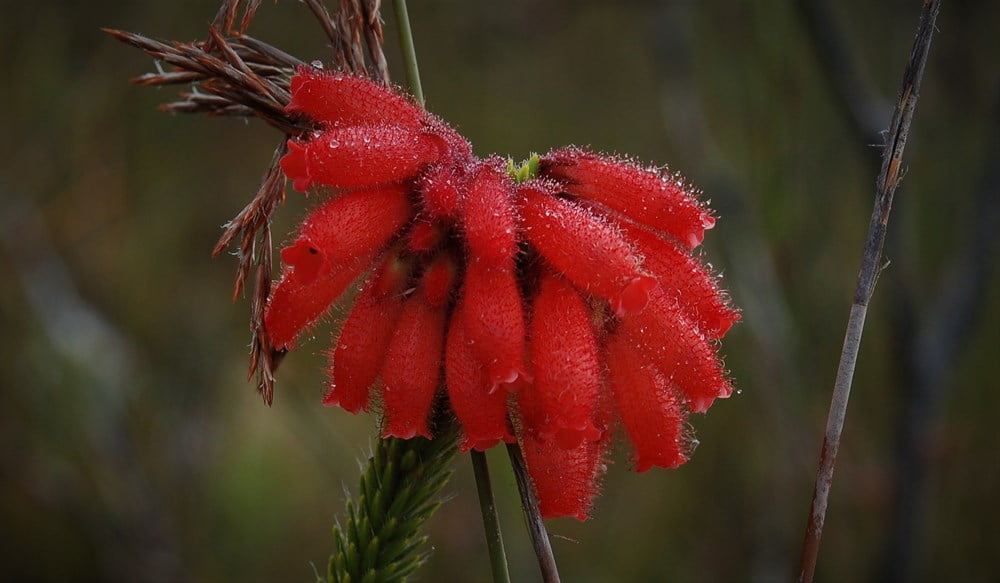“Wait a minute,” I hear savvy locals say. “The hidden gems of Elands’ Pass? Isn’t that where the N2 highway runs over those mountains near Cape Town? Do you mean Sir Lowry’s Pass? One of the busiest bits of road in the province?”
Yes I do. It may be called Sir Lowry’s Pass these days, so beloved of traffic reports (broken-down truck on the hairpin bend) but take three steps – quite literally – from the side of the road and an astonishing fynbos world opens up. The background noise may be the whoosh of rushing traffic but it is now overlaid with the songs of some of the world’s rarest birds, set against the colours of the most extraordinary and unique flowers.
It’s less than an hour’s drive from Cape Town, and not only is Elands’ Pass home to natural treasures, but there’s human history embedded in the landscape – quite literally: in places there are old ox-wagon tracks worn into the sandstone. The history goes deeper: ‘eland’ is the European word for what the Cape’s indigenous Khoisan people called Gantouw, and this was once Gantouw Pass, where the herds once picked their way down from the high ground of the Boland Mountains and onto the wet lowlands of the Cape Peninsula.

The Eland (Taurotragus oryx) remains an iconic African antelope but the name is – somewhat confusingly – the Dutch word for elk.
Oh, how the Khoisan must have celebrated the arrival of the eland! It’s the world’s largest living antelope and the biggest males weigh in at nearly a ton – a fabulous food source. No wonder 90% of animals depicted in Khoisan art are eland; the animal was as central to the Khoisan economy as surely as the buffalo was to the indigenous people of the North American grasslands.
The eland are long gone of course, but these mountains have kept their smaller treasures, and despite being within sight of Cape Town and the Cape Peninsula, Elands’ Pass provides even the most casual observer with an almost shocking example of what fynbos does really well. And that’s Gamma Diversity.

Eland’s Pass: who would think that these modest mountains so close to Cape Town would be so different in their plant species?
Next time you find yourself outside with a bit of a view, take a look around. So there’s a hill here, some fields over there, a bit of high ground further away, a valley behind you. Fine. So, how many floral field guides would you expect to need for the area? One, surely – I mean, you can see all the places in a single sweep.
But fynbos is not like that. The flower guide book for Table Mountain and the Cape Peninsula is largely redundant on Elands’ Pass because over half the plant species there are different, even though the peninsula is in plain sight. And when walking on Elands’ Pass, now armed with a new flower guide – the one for the immediate region, you can be sure that the plants on the neighbouring mountains – the Groenlandberg (Green Mountains) in this case – will have a similar but slightly different suite of plants. By the time you’ve reached those mountains on the horizon – the Cederberg – you’ll need to change your flower guide again.
Botanising in the Cape is not a cheap pursuit, I can assure you.

Another local heather is the showy Erica massonii – it’s bird-pollinated & so has sticky flowers to deter insect thieves.
Gamma Diversity measures bio-diversity over an entire landscape, and in fynbos habitats the numbers are off the scale. Think of it as a combination of Alpha Diversity (how many species in a given site, such as a forest or field) and Beta Diversity (comparing different sites). As it happens, Alpha Diversity in fynbos is high, but not as high as it is in tropical rainforests.
And although it’s true that mountains generally have high Beta Diversity – a good example close to Cape Town is Devil’s Peak – these Cape mountains have extraordinary Beta Diversity – as described above – thanks to the wildly varying landscape of geology, micro-climates and habitats.
So Gamma Diversity gives you the whole thing, and because bio-diversity is naturally high in the Cape (the region has half of South Africa’s biota), a big view will deliver a big number: run your eyes over the 70 kilometre (43 miles) Cape Peninsula and you’re looking at more plant species than there are in Canada. (See more on how fynbos diversity works here.).

Nebelia paleacea is called a Bergstompie in Afrikaans – ‘mountain stump’ – a reference to its ability to grow back from its burnt stump after fire.
Most of the bio-diversity at Elands’ Pass is found in the flora but there is wildlife to interest both specialists and casual naturalists alike. It’s an off-radar birding destination to find infuriatingly localised fynbos birds like Victorin’s Warbler (Cryptillas victorini) and Cape Rockjumper (Chaetops frenatus), and there are always one or two surprises.

At home in Eland’s Pass, the Cape Rockjumper (Chaetops frenatus) is emblematic of the fynbos birds & highly sought-after by birders.

The Red Milkweed Locust (Phymateus morbillosus) feeds on poisonous Euphorbias & is itself toxic to most predators – as it well advertises.
A recent fire at Elands’ Pass had encouraged hundreds of bright orange Watsonia schlechteri to emerge from the ground. It’s a type of Iris and if the date were several hundred years ago, the wind swirling around Eland’s Pass would have carried with it the scratchy sound of people digging them up with long wooden sticks: many species of Watsonia were known as Uintjies (little onions) to the Dutch settlers thanks to their large potato-like underground corm, a valuable food source until relatively recently.

Once dug up for food, Watsonia schlechteri adds a splash of colour to the summer mountains.

It wouldn’t be a trip to the mountains without the Chacma Baboon – Papio ursinus – guardians of Eland’s Pass – or at least its car park.
There are no foragers today of course but hikers and birders have taken their place, returning home not with uintjies but with digital images of treasures as rich as a sack full of bulbous corms. The hidden gems of Eland’s Pass.

The endangered Skyblue Tubebell (Merciera azurea) is a member of the Bell Flower family – Campanulaceae – where you’ll also find Lobelias.

This Erica cerinthoides enjoyed the fire: it’s called Fire Heath & happily grows back after a healthy incineration.

Another member of the Bell Flower family, Roella incurva also flowers profusely after fire, taking advantage of abundant sunshine & few other competitors.

Thank you so much for your regular reports. They mean the world to me, here in Northern California where I’ve lived for the past 21 years. I have never been home again, since leaving and I eagerly wait for your next picture, discovery, comment. Thank you.
Hallo Dominic
Came across your facebook page, searching for info about Fynbos.
Really impressing what you do 🙂 And still has time for blogging? Amazing.
Looking forward for more info and photos.
Regards from Germany
Linda
I love learning about these areas. My parents lived on the farm called “Honey Bos” in the Sir Lowry valley. The home was close to the river. I was born there 1948 on a Sunday morning. I was registered there or in Somerset-West. My father used to travel down the pass which was a dirt road at the time, on his motorbike. They often did so. I would love to know more about that area in those days and see photos if any. I still love mountains rivers and the sea. I trust to take a look around Sir Lowry’s pass village area again some time. Thank you for this.
And thank you for your historical insights!
Another really nice one. Thanks, Dominic.
My pleasure, thank you!